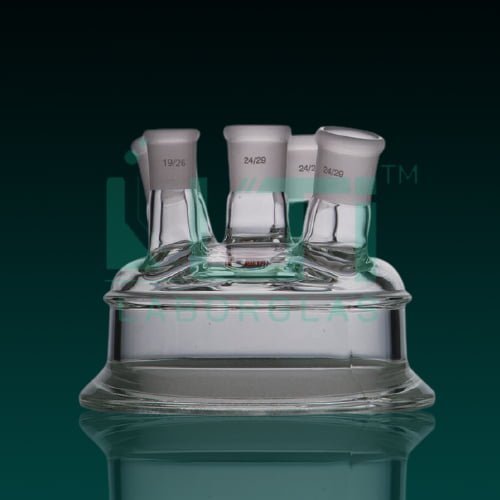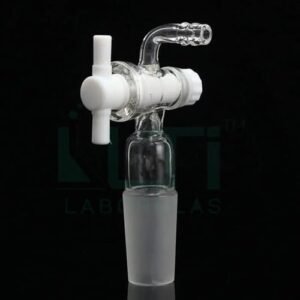- Flat Flange and Interchangeable Joint
- Made From Heat Resistant, Low Expansion 3.3 Borosilicate Glass
| PART No. | Centre | Parallel | Side 5° | Side 10° | Side 15° | PACK Qty. |
| 5810-19C19P | 19 / 26 | 19 / 26 | 24 / 29 | 19 / 26 | NA | 1 |
| 5810-19C14P | 19 / 26 | 14 / 23 | 14 / 23 | 14 / 23 | 29 / 32 | 1 |
| 5810-29C14P | 29 / 32 | 14 / 23 | 14 / 23 | 14 / 23 | 29 / 32 | 1 |
Here are some common uses for lids on reaction flasks:
- Safety and Containment: Lids are crucial for preventing the escape of volatile or hazardous substances during a chemical reaction. They provide a level of containment to ensure that reactions occur within the controlled environment of the flask.
- Gas Control: In reactions where gases are produced or consumed, lids help control the release or retention of gases. This is particularly important in reactions that involve gas evolution or require specific gas atmospheres.
- Condensation Control: Lids aid in controlling condensation within the reaction flask. This is particularly relevant when reactions involve volatile solvents or when temperature changes might lead to the formation of condensation inside the flask.
- Temperature Control: Lids contribute to maintaining a consistent temperature within the reaction vessel. They can be designed to fit snugly to reduce heat loss or to allow for the attachment of external temperature control devices.
- Reaction Monitoring: Some lids are designed with openings or ports that allow for the insertion of sensors, probes, or sampling devices. This facilitates real-time monitoring of reaction parameters such as temperature, pressure, or the concentration of reactants and products.
- Reflux Conditions: Lids with reflux condensers or cooling systems are used in reflux setups. These lids allow volatile components to evaporate and then condense back into the reaction vessel, preventing the loss of valuable reactants.
- Airtight Sealing: For reactions that require an inert atmosphere or reactions sensitive to air or moisture, airtight lids help maintain the desired reaction conditions.
- Addition of Reagents: Lids with openings or septa allow for controlled addition of reagents during a reaction without exposing the entire reaction mixture to the external environment.
- Protection from Contaminants: Lids protect the reaction mixture from contamination by dust, particulates, or unwanted impurities present in the laboratory environment.
- Workup and Product Isolation: Lids can be used during workup procedures or product isolation steps, providing a cover to protect the contents of the flask during filtration, extraction, or other processes.
- Reaction Quenching: Lids can be used to quickly quench a reaction by adding specific reagents through openings in the lid.







